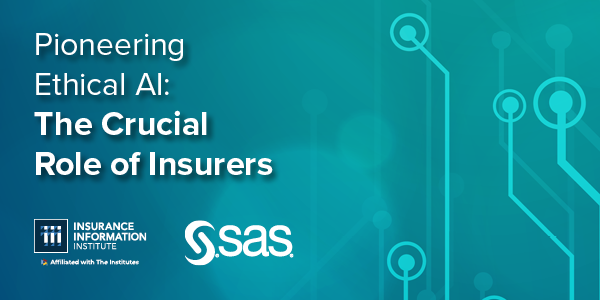[ad_1]
AI democratization has gained dizzying momentum, with know-how laypeople having quick access to extremely highly effective instruments. As of October 2024, Microsoft Copilot had an estimated 28 million customers.
AI and AI-adjacent instruments have turn out to be ubiquitous in on a regular basis life. For instance, actual property apps embed local weather danger instruments into the interface (look carefully on the accompanying video – you might even see yours actually).
So, what does this imply for the insurance coverage trade? It might be the reply to a very daunting drawback on the horizon – the silver tsunami.
The trade is in a expertise conflict. Within the US, 400,000 employees are anticipated to retire by 2026. A survey by The Institutes reveals 8 of 10 millennials have restricted data of the trade – and 44% don’t discover a profession in insurance coverage attention-grabbing.
Insurers might want to display the sexier aspect of the enterprise by highlighting alternatives to work with modern know-how.
The AI insurance coverage market is hovering
The worldwide insurance coverage analytics market is round $11.3 billion. Particularly, AI life cycle and AI software program providers are roughly 10% of that quantity – about the identical as enterprise intelligence software program. For comparability, database administration techniques are round $3.6 billion and danger administration purposes are round $1.9 billion.
The distinction is that all the insurance coverage market is simply rising round 18% three-year CAGR whereas the AI market (together with the subset of GenAI) is rising between 37% and 62%.
In latest months, we’ve seen enthusiasm with GenAI, ChatGPT and huge language fashions (LLMs) decline sharply. That’s as a result of we’re popping out of the trough of what many know because the “Gartner Hype Cycle.”
The AI explosion that got here with ChatGPT creates a polarizing debate with insurers (some are banning the know-how whereas others are embracing it). However the worth is evident.
McKinsey estimates that insurers will acquire $50 billion to $70 billion of income from the influence of GenAI throughout enterprise capabilities. In addition they report that “AI leaders” outpace “laggards” by two to 6 instances on whole shareholder returns, throughout each sector analyzed (together with insurance coverage).

Nonetheless not utilizing AI? Time to scratch that itch.
We are able to quantify AI’s perceived influence, and we all know that insurance coverage work will change consequently.
In his e book, “The Financial Singularity,” creator Calum Chace connects the idea of Fifteenth-century Dutch employees throwing their wood footwear (sabots) into textile looms, enraged that the know-how would take their jobs. However in each historic occasion (he continues), humanity has upskilled itself.
This reskilling began with the daybreak of producing and has continued to the fourth industrial revolution (or Business 4.0): the mixing of bodily and digital worlds via AI and autonomous techniques. With that integration, we should talk about the necessity for insurers to place themselves as AI-forward establishments to the following technology of insurance coverage professionals.
The bionic workforce
Experiences from Microsoft and LinkedIn discovered that 68% of individuals battle with the tempo and quantity of labor. About 46% are burned out, and 54% of early profession staff’ selections to work for one employer versus one other could be influenced by entry to AI.
AI fans proceed to share “time financial savings” as an exquisite utility for including worth. AI assistants like copilots not solely save time. In addition they permit staff, similar to underwriters, entry to massive information units, market dynamics and new info – issues that aren’t available via a cursory Google search.
Integrating AI with enterprise processes – an instance
Let’s think about an underwriter reads a paper from the Institute of Catastrophic Loss Discount (ICLR) analyzing the Lytton, British Columbia hearth (June 30, 2021). In it, she learns {that a} construction’s “ignition zone” falls inside 30 meters or round 98 ft (web page 18).
Her enterprise lately built-in aerial imagery into her underwriting workbench to fight wildfires. The platform presents low- and no-code options, so writing a program to find out the gap from a construction to vegetation is completed in minutes.
With this information, she asks Microsoft Copilot the next immediate about her territory: “Hey, Copilot. Please present a listing of all insured areas in Alberta, Canada inside 99 ft of dense vegetation. Thanks, Copilot.”
Science fiction? Nope.
These laptop imaginative and prescient, GenAI and machine studying applied sciences are all obtainable, right this moment (attend ITC Vegas simply as soon as, and also you’ll see what I imply).
Armed with this new info, the underwriter may work together with her distribution, loss management and neighborhood companions to handle areas most vulnerable to wildfire danger. That is the profitable integration of AI with right this moment’s enterprise processes and represents the true “final mile” problem for insurers.
AI assistant versus AI agent
As Neo discovers in Matrix Reloaded, the issue is alternative. Within the above instance, the human has the company to determine what motion to take, whereas AI brokers have autonomy to behave to attain predetermined targets.
Insurance coverage is the enterprise of constructing selections. Determination intelligence is growing in significance as insurers look to make use of information to drive extra environment friendly decision-making whereas lowering prices and sustaining applicable danger controls throughout each aspect of the insurance coverage equation – from quote to say.

Selections by AI – black field or clear?
There’s a cross-section of AI brokers which are “black field” (their operations usually are not seen or simply explainable). In some instances, insurers might select to make use of these instruments, however they should determine which duties an AI black field can safely deal with.
All fashions drift, black or white, and because the title implies, machines be taught. In consequence, brokers’ capabilities change.
Using an AI agent to underwrite insurance policies or settle claims comes with danger. And a few duties shouldn’t be automated in any respect. In some geos, sure AI makes use of are forbidden, whereas others usually are not.
Take the EU. What if AI had been used to control policyholders into shopping for pointless protection, or to launch fraud investigations primarily based on social scoring? The EU AI Intelligence Act would place each within the “unacceptable danger” class.
The position of literacy, training and governance
AI literacy is invaluable and is even required by some laws. However to appreciate efficient, measurable and clear outcomes, employees should be upskilled.
Organizations like PZU (a bigger European insurer) – with clearly outlined AI identities (similar to established AI tips and guardrails) – present fertile floor for insurance coverage professionals to securely use algorithmic, autonomous and synthetic intelligence applied sciences. At a minimal, having clear positions on AI and its use, together with a powerful tradition and educated workers, will defend insurers from noncompliance with AI laws.
Study concerning the deep worth of AI governance – and the position insurers can play in moral AI.
The underside line: Individuals won’t ever exit of enterprise
Insurance coverage is a noble career. AI unlocks the trade’s potential to shift into “warp velocity.” It doesn’t, nonetheless, substitute the proficient women and men we’ve got underwriting insurance policies, settling claims or serving to prospects with their wants.
Remember that folks depend upon AI markets for his or her livelihood. Think about the UK, the place 524 UK-based AI corporations make use of round 12,000 folks. This market is poised to develop sixfold over the following decade, unlocking greater than £6.5 billion of worth.
With this explosion are requires AI security. Each the UK and Singapore have responded by signing AI security agreements, additional signaling the necessity for worldwide cooperation in using these highly effective instruments.
People are essential to making sure security. As a place to begin, all insurers ought to take these subsequent, quick steps:
Set up clear guardrails on the right use of AI.
Combine a Code of Information Ethics into your worker handbook and different governing paperwork.
Assign AI authority grants to staff for utilizing AI instruments, together with the facility to halt using AI techniques and alert govt management when essential points come up.
You wouldn’t permit a copilot you possibly can’t belief within the cockpit to fly the aircraft. The identical applies to AI for what you are promoting.
Find out how and why to put money into reliable AI
Able to develop premiums, cut back prices and create efficiencies? It’s time to put money into synthetic intelligence software program, educate workers on tips on how to use it responsibly and stretch your typical considering on all insurance coverage processes.

Obtain a paper to be taught extra concerning the essential position insurers play in moral AI
[ad_2]
Source link




